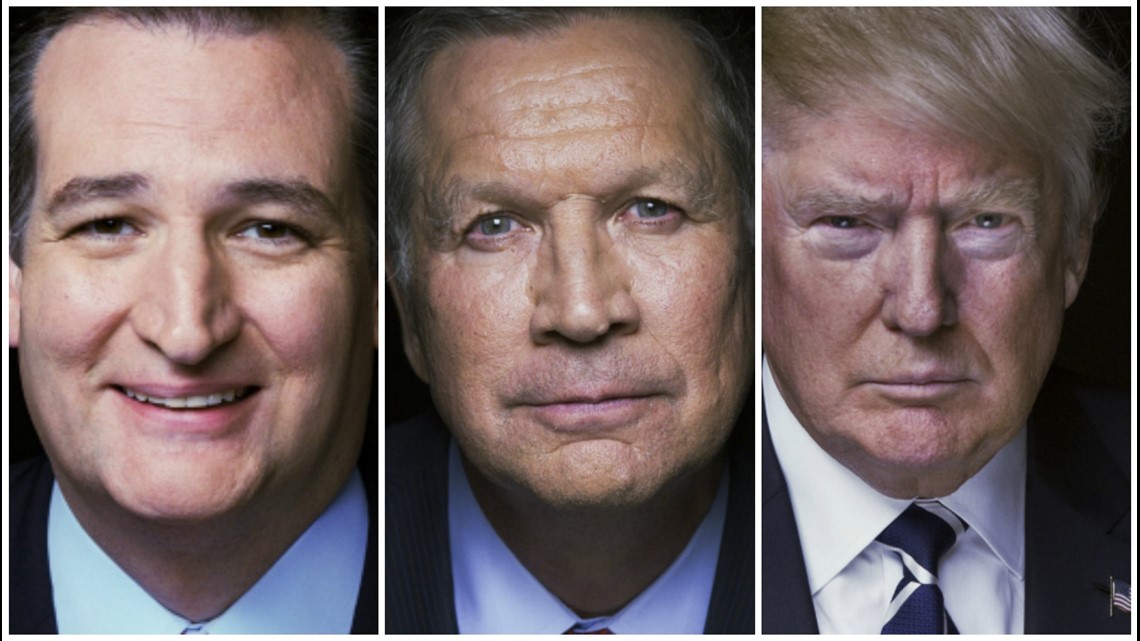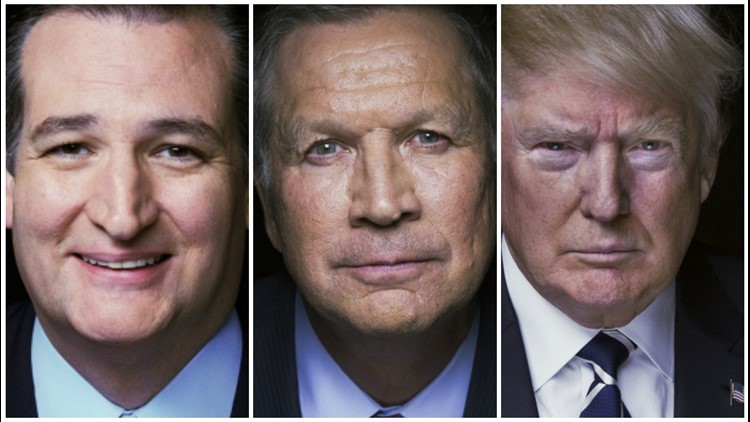

To stop the billionaire from hitting, or coming very close to, the magic number of 1,237 delegates needed to seal the Republican nomination and to raise the prospect of a contested convention, they must do more than simply start snapping up victories in the remaining nominating contests: They must fundamentally reshape the political map.
Cruz, the Texas senator seen as extreme by many mainstream voters, would suddenly have to start appealing to moderates. And Kasich, the Ohio governor branded a RINO (Republican in Name Only) by many grass-roots activists must suddenly find an invisible connection to conservatives.
And even if that worked, both men would have to start winning big in precincts and entire states that look nothing like those where they have had success so far.
“If things continue on the same trajectory that they are on right now. Trump is going to get to 1,237 delegates or awfully close to 1,237,” said University of Georgia Professor Joshua Putnam, an expert of the delegate math and publisher of the Frontloading Hq blog.
According to the latest CNN estimate, Trump leads the race with 741 delegates, Cruz has 461 and Kasich, who has only won his home state of Ohio, has 145. Marco Rubio captured 166 delegates before he left the race.
To clinch the nomination, Trump needs to win just 55% of the remaining 899 delegates. Cruz needs 86% and Kasich needs 121% — in other words, hundreds of delegates that don’t actually exist. To show the improbable nature of Cruz’s task, Trump’s dominant position in the delegate count is based on winning only around 47% of the delegates so far awarded.
But the race is also certain to take several months to wrap up. The primary schedule means Trump will have to at least wait until the June 7 contests — including the mammoth California primary with its 172 delegates — before he can definitively clinch the nomination.
Cruz is billing himself as the only candidate with a real chance of slowing Trump — a task he says is complicated by Kasich’s continued campaign.
“You can’t lose every state and expect to be the nominee,” Cruz told CNN’s Chris Cuomo on “New Day” on Wednesday. “Right now, Kasich’s role is really being a spoiler. Kasich benefits Donald Trump.”
But Kasich maintains that no candidate is likely to reach the delegate total needed to win the race, so to leave now would be “nuts.”
“I am not going anywhere, am I a spoiler, of course I am not a spoiler,” Kasich said on CNN on Monday.
Sure, Cruz does have a mathematical chance of overcoming Trump’s delegate lead and clinching the nomination himself before the Cleveland convention in July — but it would essentially require running the table. So hopes o halting Trump rely on him being stopped so far short of the 1,237 barrier that an attempt to deprive him of the nomination at the convention does not smack of a coup against millions of Trump voters.
Map favors Trump, Kasich
The system of doling out delegates in each state — some are winner take all, some are proportionately awarded, and some have intricate hybrid distribution formulas — is so complicated it’s just not possible to say how the math will play out.
Trump’s exact final number could depend on whether he reaches 50% thresholds some states and congressional districts require for a winner take all distribution of their delegates.
A key reason why Trump has such a strong advantage is the makeup of the remaining states.
Many of them have characteristics that favor the reality star, for example, because they are in northeast with crops of less ideological, lower middle class and working class voters, where he has done well so far this convention season.
So, the billionaire is confident of prospering in New York, Connecticut, Maryland, Pennsylvania, California and New Jersey for example.
“No one has yet been able to reduce Donald Trump’s percentage of the vote,” said Henry Olsen, an elections analyst at the Ethics and Public Policy Center. “Assuming that continues, “Cruz either needs to start appealing to moderates, or Kasich needs to start appealing to conservatives. Neither has been able to do that at all. Neither seems to be showing an inclination to really try.”
Olsen says the headache for party figures desperate to stop Trump is that neither Cruz, nor Kasich have the cross-over appeal to consolidate all opposition to the former reality star.
“The fundamental problem is that Kasich does not appeal to conservatives in a two-person race — there are a substantial number of conservatives that prefer Trump to Kasich. Then, moderates in places like Wisconsin that permit non Republicans to vote tend not to like Cruz.”
What Cruz needs to do
Cruz says that if he was the last man standing, he would beat Trump.
“Trump has a hard ceiling of 35 to 40 percent that he has real trouble crossing and (in) the head-to-head, we not only beat Donald, we beat him badly. We beat him by double digits. What Kasich can do is — is pull enough votes away to let Trump win with a plurality.”
But the reality of the political map shows things are far more complicated than that.
It is theoretically possible for Cruz to stop Trump’s nomination before the convention — but it’ll require Cruz to go on a near-perfect run through the West and Kasich to turn the race on its head by showing he can win urban and suburban areas.
It has to start with Wisconsin on April 5 — “a battleground,” Cruz said Thursday, where he and Trump run neck-and-neck.
There are also three must-wins on his calendar: Nebraska, Montana and South Dakota, with a combined 92 delegates on the line. Cruz’s wins in Utah, Kansas and Oklahoma suggest he can compete in those rural Plains and Western states. If he doesn’t sweep them, he’d be unlikely to win anywhere else, and Trump would be hard to stop.
The case for Kasich
For Kasich, a crucial eight-day stretch starts on April 19 in New York — the state Trump has called home his entire life.
So far, the largest Northeastern state to vote has been Massachusetts — where Trump crushed Kasich, 49% to the Ohio governor’s 18%, with the since-departed Marco Rubio right behind at 17.9%. Kasich also ran second to Trump in New Hampshire and Vermont.
All along, Kasich’s argument has been that he can win moderates. It’s just a notion at this point, since Kasich has only won one state — his own.
But if he can somehow change the fundamental dynamics of the race, rocket up the polls and win suburban regions of New York, it’d stop Trump from sweeping nearly all of the state’s 95 delegates. It’d also foreshadow the following week, when five more East Coast states vote: Connecticut, Delaware, Maryland, Pennsylvania and Rhode Island.
Kasich might not win any of those five states, but he could win individual congressional districts and keep the front-runner below 50%, slowing Trump’s collection of delegates.
June 7
It could all build to high drama on June 7 — the last day of Republican primaries and caucuses, with a huge pot of 303 delegates on the line.
Among those are Cruz’s targets of Montana and South Dakota, as well as New Mexico, with a proportional allocation that’s unlikely to yield huge advantages for any candidate.
Then, there are the two that could push Trump over the top: California, with its 172 delegates, nearly all of which could go to the front-runner’s camp given its winner-take-all rules for the state and district levels, and New Jersey, where the state’s winner gets all 51 delegates.
Unpledged delegates
If that is not all complicated enough, things get even more difficult to predict.
There are also a number of delegates that haven’t been handed to any of the three candidates still in the race — putting them in play if the fight goes to the Republican National Convention in Cleveland.
Trump won’t win all of those delegates but is sure to lock in the support of some — which is why it could take until the first ballot before it’s clear whether he’s reached 1,237.
Three of the remaining states — Colorado on April 9, Wyoming on April 16 and West Virginia on May 10 — don’t allow their voters to pick candidates directly. Instead, they elect delegates to the convention — which means those delegates (34 from Colorado, 14 from Wyoming and 34 from West Virginia) are all in play for every candidate.
Another 54 unpledged delegates come from Pennsylvania, where Trump and Kasich are headed for a showdown.
If Trump is inches away from 1,237, he could cross the threshold by winning a share of those delegates. If he doesn’t get there, though, things could come unspooled almost immediately — especially since Cruz has focused on getting delegates on the slate who might be legally bound to back Trump in the first round of voting, but could switch to his camp on the second or third rounds.
And there’s another big pool of delegates is sprung free on the second ballot.
Rubio’s 166 delegates could then come into play. A smattering of 16 more are divided between Ben Carson, Jeb Bush, Carly Fiorina, Mike Huckabee and Rand Paul, and another 29 aren’t bound to any specific candidate.
Another 12 will go to the winner of the Missouri primary once those results are certified — likely giving Trump a bit of a boost, if his lead there holds — and three more haven’t been allocated in Mississippi.
Amid the chaos of a contested convention, with the complicated delegate math shifting by the minute, Trump’s self-appointed title as the world’s greatest deal maker could face its toughest test.



